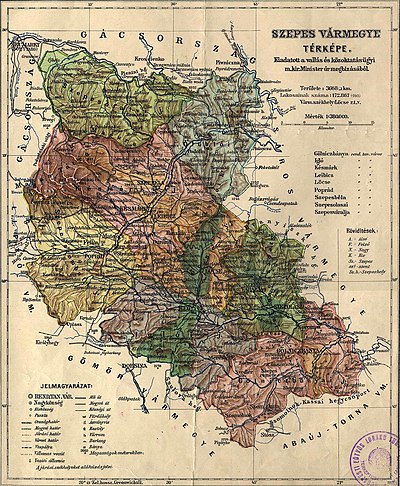Szepes County
The original seat of government of Szepes county was Spiš Castle (Hungarian: Szepesi vár), which was constructed in the 12th century.The rulers of the county were from the following Hungarian noble families: Until 1802, there was a Seat of the 10 Lance-bearers, an autonomous administrative division, which was situated to the east of Poprad in present-day southern Spiš, and whose origin is unknown.The major immigration came following the devastating Mongol invasion of 1242, which turned Szepes, like other parts of the Kingdom of Hungary, into a largely depopulated area (some 50% of the population was lost).In the early 13th century, the people of Szepes created their own religious organization called the "Brotherhood of the 24 royal parish priests", which received many privileges from the local provost.From 1370 the 41 settlements of the territory subscribed to a uniform special Szepes law system (called Zipser Willkür in German).The Province of 24 Szepes towns was dissolved in 1412, when, by the Treaty of Lubowla King Sigismund of Luxembourg, ruler of Hungary, pawned 13 of the towns of the former Province, as well as the territory around the Ólubló (present-day Stará Ľubovňa) (i.e. the royal domain Lubló, plus Gnézda and Podolin, and several villages) to Poland, in exchange for the amount of 37,000 Czech sixty-groschen coins, that is, approximately 7 tonnes of pure silver.The Polish king ceded his interest in the towns to Count Sebastian Lubomirski in 1593, whose family then became effectively the proprietors of the province.The Szepes county (today mostly Spiš region) prospered not only from being situated on trade routes, but also from its natural resources of wood, agriculture and, until relatively recent times, mining.The buildings and churches of the region's towns, and the skills of schools such as those of the carver Master Paul of Levoča testify to this affluence and culture.In the Catholic sphere, a separate Szepes Bishopric was created in 1776 with its seat at Szepeshely (present-day Spišská Kapitula).On the other, it bypassed the old capital of the region, Lőcse (now Levoča), and favoured the growth of centres on its route, such as Poprád (now Poprad) and Igló (now Spišská Nová Ves).In the aftermath of World War I, Szepes county became part of newly formed Czechoslovakia, as recognized by the concerned states in the 1920 Treaty of Trianon.According to censuses carried out in the Kingdom of Hungary in 1869 (and later in 1900 and 1910) the population of Szepes county comprised the following nationalities: Slovaks 50.4%, (58.2%, 58%), Germans 35% (25%, 25%), Ruthenians (Rusyns[citation needed]) 13.8% (8.4%, 8%) and 0.7% (6%, 6%) Magyars (Hungarians).The sudden increase in listed Hungarians after 1869 may be due to statistical interpretation (use of "most frequently used language" as criterion); it may also be attributable to assimilation, Magyarisation, most notably of the German minority.Up until now, there is a significant population (about 40,000 to 48,000 estimated) of ethnic Poles[dubious – discuss] (practically without any exception, the Gorals using Polish dialect of Szepes region).The Slovak and German inhabitants came to Szepes in following centuries in a process of colonization the Carpathian wilds by Hungarian Crown.





HungarianGermanSlovakCountyKingdom of HungarySzepesi várSlovakiaPolandSpiš CastleLevočaPolishLiptóGömör-KishontAbaúj-TornaSárosGaliciaCzechoslovakiavery small area now in PolandWorld War IKežmarokPodolínecDunajecHniezdneStará ĽubovňaHabsburgthe Kingdom of HungaryKošicePrešovZápolyaThurzóCsákySeat of the 10 Lance-bearersautonomous administrative divisionPopradGermansHungariansAbrahámovceBetlanovceGánovceSpišské TomášovceHôrkaHozelecJánovceVlkovásquiresSpišský ŠtvrtokMongolBéla IV of HungaryTransylvaniaCarpathian GermansprovostStephen VCharles IoligarchsRozgonyroyal free townsLőcseKésmárkProvince of 24 Szepes TownsSpišská SobotaTreaty of LubowlaSigismund of LuxembourgpawnedGnézdaPodolingroschenRepublic of VeniceĽubicaSpišská Nová VesSpišské PodhradieSpišské VlachyTvarožnáfealtyPolish kingsSebastian LubomirskiEsztergomdiocesestarostaZawisza CzarnyTeodor Konstanty LubomirskiMaria Josepha of AustriaAugust III of PolandMaria Theresa of AustriaPolish noble insurrectionsStanislaus II of PolandFirst Partition of PolandMaster Paul of LevočaHabsburgsLutheranProtestantBishopricSpišská KapitulaSlovaksTreaty of Trianonmother tongueRuthenianreligionRoman CatholicGreek CatholicJewishRusynsMagyarisationGoralsSlovakizationtoday PopradVistulaBaltic SeaHornadSądecczyznaPodhaleprocessusesGelnicaSpišská Stará VesSpišská BeláList of administrative divisions of the Kingdom of HungaryNyitra countyPozsony countyBrandenburgLands of the Crown of Saint StephenAlsó-FehérBács-BodrogBaranyaBékésBeszterce-NaszódBorsodBrassó